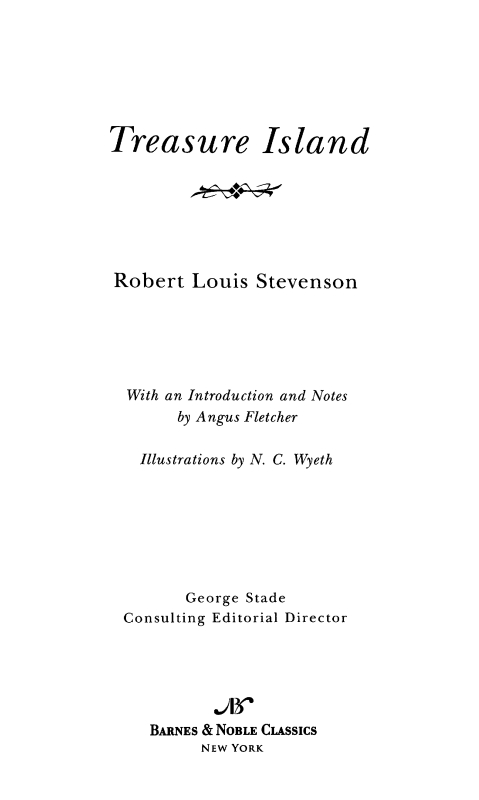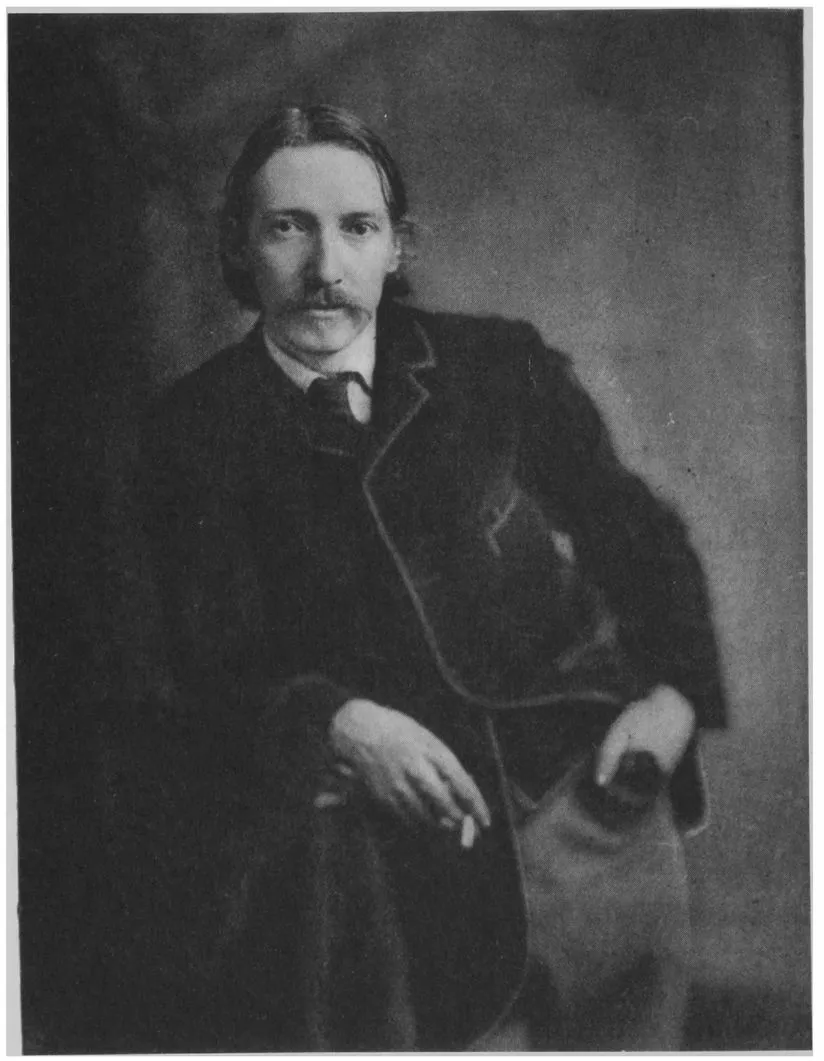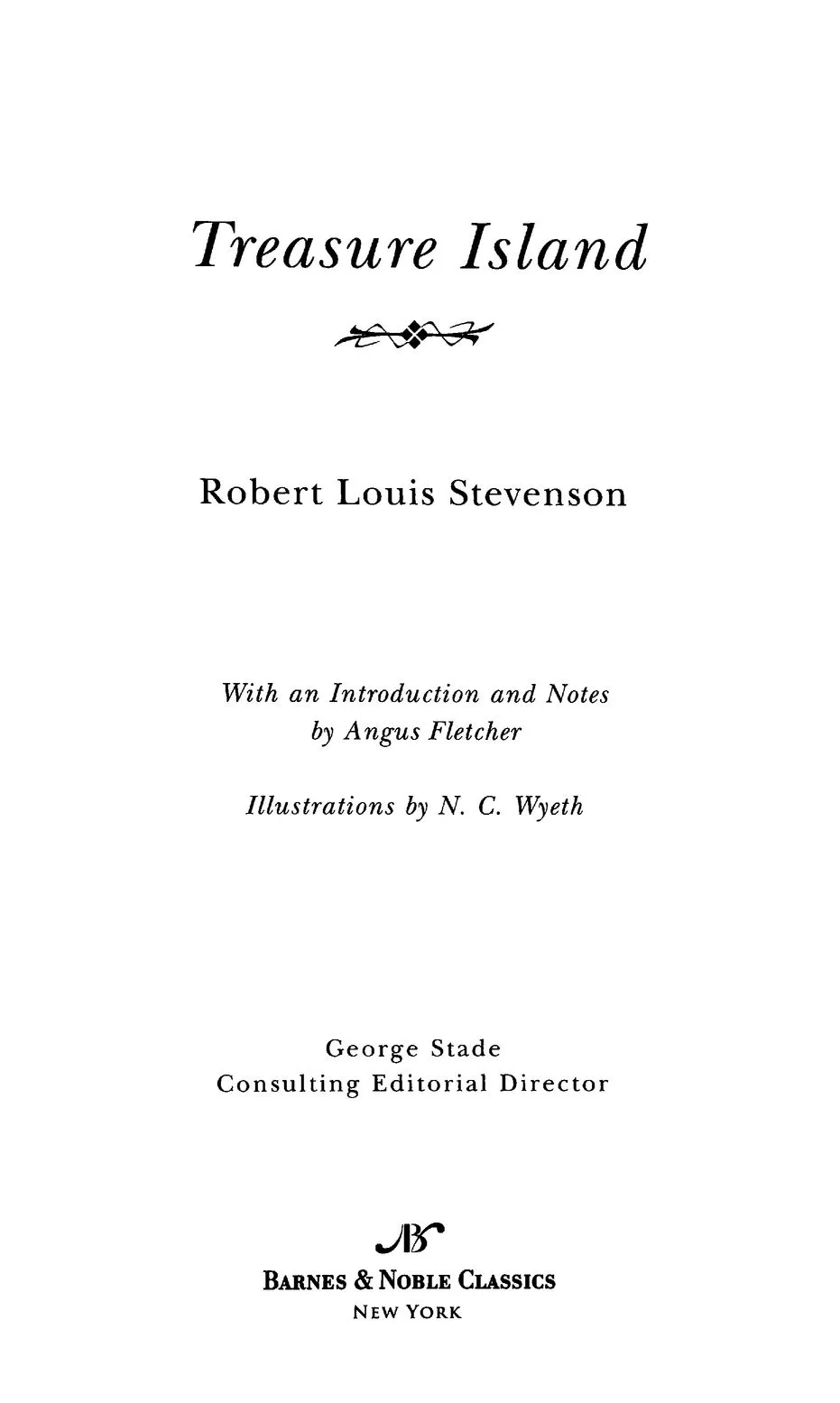Treasure Island

Table of Contents
From the Pages of Treasure Island
Title Page
Copyright Page
Robert Louis Stevenson
The World of Robert Louis Stevenson and Treasure Island
Introduction
Dedication
TO THE HESITATING PURCHASER
PART I - The Old Buccaneer
I - The Old Sea-dog at the Admiral Benbow
II - Black Dog Appears and Disappears
III - The Black Spot
IV - The Sea-chest
V - The Last of the Blind Man
VI - The Captain’s Papers
PART II - The Sea Cook
VII - I Go to Bristol
VIII - At the Sign of the Spy-glass
IX - Powder and Arms
X - The Voyage
XI - What I Heard in the Apple Barrel
XII - Council of War
PART III - My Shore Adventure
XIII - How My Shore Adventure Began
XIV - The First Blow
XV - The Man of the Island
PART IV - The Stockade
XVI - Narrative Continued by the Doctor: How the Ship Was Abandoned
XVII - Narrative Continued by the Doctor: The Jolly-boat’s Last Trip
XVIII - Narrative Continued by the Doctor: End of the First Day’s Fighting
XIX - Narrative Resumed by Jim Hawkins: The Garrison in the Stockade
XX - Silver’s Embassy
XXI - The Attack
PART V - My Sea Adventure
XXII - How My Sea Adventure Began
XXIII - The Ebb-tide Runs
XXIV - The Cruise of the Coracle
XXV - I Strike the Jolly Roger
XXVI - Israel Hands
XXVII - “Pieces of Eight”
PART VI - Captain Silver
XXVIII - In the Enemy’s Camp
XXIX - The Black Spot Again
XXX - On Parole
XXXI - The Treasure-hunt—Flint’s Pointer
XXXII - The Treasure-hunt—The Voice Among the Trees
XXXIII - The Fall of a Chieftain
XXXIV - And Last
Endnotes
Inspired by Treasure Island
Comments & Questions
For Further Reading
From the Pages of Treasure Island

Squire Trelawney, Dr. Livesey, and the rest of these gentlemen having asked me to write down the whole particulars about Treasure Island, from the beginning to the end, keeping nothing back but the bearings of the island, and that only because there is still treasure not yet lifted, I take up my pen in the year of grace 17—and go back to the time when my father kept the Admiral Benbow inn and the brown old seaman with the sabre cut first took up his lodging under our roof. (page 11 )
“Fifteen men on the dead man’s chest—
Yo-ho-ho, and a bottle of rum!
Drink and the devil had done for the rest—
Yo-ho-ho, and a bottle of rum!” (page 16)
“Heard of him, you say! He was the bloodthirstiest buccaneer that sailed. Blackbeard was a child to Flint. The Spaniards were so prodigiously afraid of him that, I tell you, sir, I was sometimes proud he was an Englishman.” (page 45)
Long John Silver, he is called, and has lost a leg; but that I regarded as a recommendation, since he lost it in his country’s service, under the immortal Hawke. (page 53)
It was Silver’s voice, and before I had heard a dozen words, I would not have shown myself for all the world, but lay there, trembling and listening, in the extreme of fear and curiosity, for from these dozen words I understood that the lives of all the honest men aboard depended upon me alone. (page 75)
The cry he gave was echoed not only by his companions on board but by a great number of voices from the shore, and looking in that direction I saw the other pirates trooping out from among the trees and tumbling into their places in the boats. (page 118)
“A man who has been three years biting his nails on a desert island, Jim, can’t expect to appear as sane as you or me. It doesn’t lie in human nature.” (page 131)
Indeed, as we found when we also reached the spot, it was something very different. At the foot of a pretty big pine and involved in a green creeper, which had even partly lifted some of the smaller bones, a human skeleton lay, with a few shreds of clothing, on the ground. I believe a chill struck for a moment to every heart. (page 216)



Published by Barnes & Noble Books
122 Fifth Avenue
New York, NY 10011
www.BookishMall.com.com/classics
The Sea Cook, or Treasure Island was serialized in Young Folks between October 1881 and January 1882, then published in volume form in 1883 as Treasure Island.
Published in 2005 by Barnes & Noble Classics with new Introduction, Notes, Biography, Chronology, Inspired By, Comments & Questions, and For Further Reading.
Introduction, Notes, and For Further Reading
Copyright © 2005 by Angus Fletcher.
Note on Robert Louis Stevenson, The World of Robert Louis Stevenson and
Treasure Island, Inspired by Treasure Island, and Comments & Questions
Copyright © 2005 by Barnes & Noble, Inc.
All rights reserved. No part of this publication may be reproduced or transmitted in any form or by any means, electronic or mechanical, including photocopy, recording, or any information storage and retrieval system, without the prior written permission of the publisher.
Barnes & Noble Classics and the Barnes & Noble Classics colophon are trademarks of Barnes & Noble, Inc.
Treasure Island
ISBN-13: 978-1-59308-247-5 ISBN-10: 1-59308-247-9
eISBN : 978-1-411-43334-2
LC Control Number 2004112103
Produced and published in conjunction with:
Fine Creative Media, Inc.
322 Eighth Avenue
New York, NY 10001
Michael J. Fine, President and Publisher
Printed in the United States of America
QM
9 10 8
Robert Louis Stevenson

The name Robert Louis Stevenson is synonymous with adventure, romance, and the exotic—qualities that characterized the author’s life as well as his fiction. Born in Edinburgh on November 13, 1850, Stevenson contracted in his early years what was probably tuberculosis, a condition that would cause repeated bouts of illness throughout his life. But frequent confinement to the sickbed did not stifle the child’s imagination. The young boy wrote tales based on biblical passages and Scottish history and soon gained a reputation as a storyteller.
In 1867 Stevenson enrolled in Edinburgh University. His family expected that he would join the distinguished line of Stevenson engineers; instead he chose to study the law. But conventional study was, he later claimed, the farthest thing from his mind. “To play the fiddle, to know a good cigar, or to speak with ease and opportunity to all varieties of men”—these were Stevenson’s youthful pursuits, which he sought despite academic and familial consequences.
This self-professed idler was a devoted student of the curriculum he devised for himself. Sometimes on the verge of grave illness, Stevenson wandered through the wilder quarters of Edinburgh, and he worked at honing his writing skills by imitating his favorite authors, among them Defoe, Hazlitt, and Montaigne. In 1875 he passed the bar exam, but rather than take up legal practice, he set out for the European continent; his time there is recounted in early essays and travel narratives. While in France Stevenson fell in love with Fanny Osbourne, a married American woman ten years his senior. He joined Fanny in the United States in 1879. Upon her divorce in 1880 she and Stevenson were married; they lived for a short time af terward in northern California.
Stevenson then returned to Edinburgh with Fanny and her son from her first marriage, Lloyd Osbourne. Stevenson’s health was so fragile for the next several years that sometimes he was bedridden; at other times he and his family traveled to the south of France and Switzerland in hopes of restoring his well-being. As in his youth, sickness galvanized rather than diminished his imagination; during this period he composed such classics as Treasure Island (1883), A Child’s Garden of Verses (1885), and The Strange Case of Dr. Jekyll and Mr. Hyde and Kidnapped (both 1886).
1 comment